During the 40-some years since the normalization of diplomatic relations between Japan and China in 1972, the Japanese economy advanced for the first 20 years, while the Chinese economy remarkably came to the forefront in the second 20 years. With this as a backdrop for Japan, China has evolved from being a recipient of aid to an equal partner, and its importance as not only a workshop but also a market has been increasing. However, the complementarity of the two countries has not been fully exploited, hampered by political conflict over territorial issues and historical perceptions.
China has surpassed Japan in terms of economic power
Between 1980 and 2013, China's gross domestic product (GDP) rose sharply from 27.9% to 1.87 times that of Japan (Figure 1). At the same time, while Japan's share of world trade has declined sharply, China's share has increased significantly (Figure 2). Against this background, the dependence of Japan on China in terms of both exports and imports has risen sharply, in contrast to a large fall in the dependence of China on Japan (Figure 3).
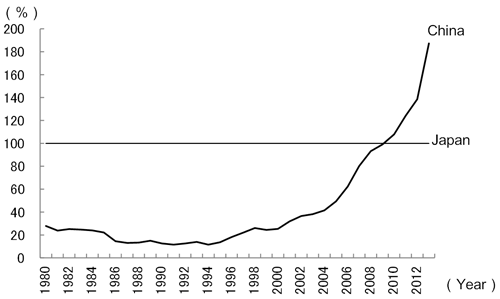
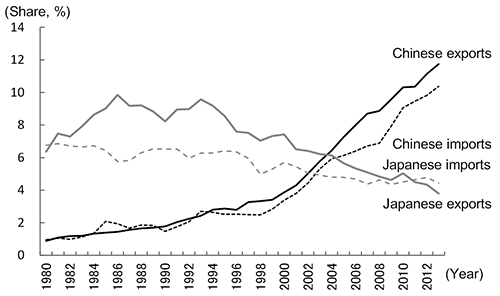
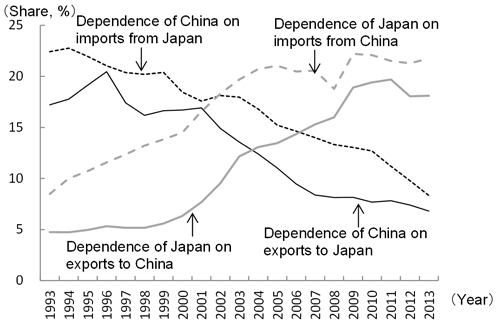
Financially, China has emerged as the world's second largest net creditor country after Japan. As of the end of 2013, net external assets of China amounted to $2.0 trillion, short of Japan with net external assets of $3.1 trillion, but China's foreign exchange reserves reached $3.8 trillion, about three times the level of Japan. Partly due to backing from the government, the size of China's outward direct investment has also increased sharply, approaching the level of Japan on a flow basis (Figure 4). In the future, as the liberalization of capital flow progresses, foreign portfolio investments by private capital are also expected to increase, further boosting the presence of Chinese money in international financial markets.
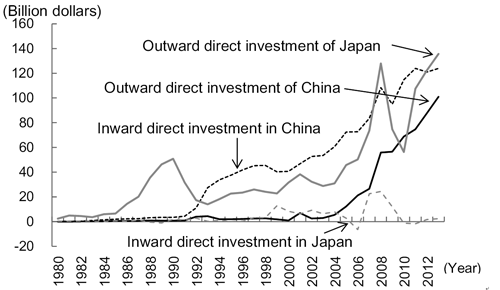
From a recipient of aid to an equal partner
Driven by these developments, for Japan, China has shifted from being a supplier of primary commodities to a production base for exports as well as a market.
During the 1980s, the mainstay of China's exports was primary commodities, notably, crude oil. However, with the building of a socialist market economy set as the goal of economic reform in 1992, China began to attract attention as a production base for exports from companies around the world, and Japanese companies were no exception in stepping up direct investment in China, mainly producing labor-intensive products. As a result, the share of China's exports accounted for by manufactured goods rose sharply, and this trend was also noticeable in its exports to Japan.
In more recent years, the importance of China for Japanese companies as not only a workshop but also a market has been increasing. According to the "Quarterly Survey of Overseas Subsidiaries" of the Ministry of Economy, Trade and Industry, local production by Japanese companies in China (including Hong Kong) increased from $25.1 billion to $226.5 billion between fiscal 2001 and fiscal 2013, while local sales surged from $8.7 billion to $144.6 billion, and the local sales ratio rose from 34.6% to 63.8%. This is largely a result of the expansion of automobile production targeting the local market. In 2013, auto sales in China reached 21.98 million units, the world's largest. Sales of passenger cars alone reached 17.92 million units, of which Japanese cars represented 2.93 million units (based on data from the China Association of Automobile Manufacturers).
In addition, the flow of funds between Japan and China is changing from a one-way flow from Japan to China to a two-way flow that also includes flow in the opposite direction.
Initially, the flow of funds from Japan to China was centered on official development assistance (ODA). Yen loans, which accounted for the majority of Japanese ODA to China, reached a cumulative 3,316.4 billion yen from the first one in 1979 to their end in 2007 (based on data from the Ministry of Foreign Affairs of Japan). From the 1990s, as reform and open-door policies and economic development progressed in China, direct investment by private-sector companies began to increase, with the balance of direct investment in China reaching 10.3 trillion yen as of the end of 2013 (Bank of Japan, "Regional Direct Investment Position, Regional Portfolio Investment and Financial Derivatives Position").
Meanwhile, Chinese investment in Japan has also increased in recent years. First, direct investment by Chinese companies through mergers and acquisitions (M&A) has been particularly noticeable, as shown by the acquisition of the personal computer business of NEC Corporation by Lenovo Group Ltd. and the acquisition of the home appliance business of Sanyo Electric Co., Ltd. by Haier Group. Direct investment is an effective tool for Chinese companies to acquire technologies and brands and offers great advantages to Japanese companies as well, as they bring financial support and a foothold in the fast-growing Chinese market. In addition, China is purchasing massive quantities of Japanese government bonds (JGBs) as part of the investment of its foreign exchange reserves. As of the end of 2013, the amount of Japanese bonds, mostly JGBs, held by China reached 14.3 trillion yen (Bank of Japan, "Regional Direct Investment Position, Regional Portfolio Investment and Financial Derivatives Position"), and China has become the largest foreign sovereign holder of JGBs.
Business opportunities for Japanese companies
Although China's economic power has surpassed that of Japan in terms of GDP, its per-capita GDP was still less than $7,000 in 2013, nowhere near Japan's per-capita GDP of approximately $40,000, given that the Chinese population is about 10 times that of Japan's. In addition, looking at other indicators, such as average life expectancy, infant mortality, the ratio of primary industry to GDP, Engel's coefficient in urban areas, and electricity consumption per capita, the latest numbers in China are roughly at the level of Japan in the early 1970s, suggesting that the difference in the development stage between Japan and China is about 40 years (Table 1) (Note). This implies that the two countries are in a complementary relationship, rather than a competitive relationship, so that there is plenty of room to cooperate.
| Present day China | Japan some 40 years ago | |
|---|---|---|
| Life expectancy (years) * | 74.8 | 74.8 |
| (2010) | (1976) | |
| Infant mortality rate (per thousand) | 13.1 | 13.1 |
| (2010) | (1970) | |
| Primary sector as a share of GDP (%) | 10.0 | 10.1 |
| (2013) | (1968) | |
| Engel's coefficient (%) ** | 35.0 | 35.1 |
| (2013) | (1966) | |
| Per capita electricity consumption (kwh) | 3967 | 4063 |
| (2013) | (1976) | |
Notes:
Source: Compiled by the author based on official statistics of China and Japan. | ||
The complementary relationship described here means that Japan is weak in areas where China is strong, while it is strong in areas where China is weak. This is in contrast with a competitive relationship, which would mean that Japan is strong in areas in which China is also strong, as well as weak in areas where the latter is also weak. In fact, looking at the relationship between the two countries from the perspective of division of labor among different products, the areas of specialty of Japan and China are concentrated on high-tech and low-tech products, respectively. In the division of labor among different production process along the supply chain, Japan excels in upstream processes (research and development and the production of key components) and downstream processes (branding and sales and after-sales services) with high added value, while the strength of China is limited to the manufacturing process, such as assembly (Figure 5). While a competitive relationship implies a zero-sum game, in which if one party gains, the other party loses, a complementary relationship can be a win-win game where both parties gain.
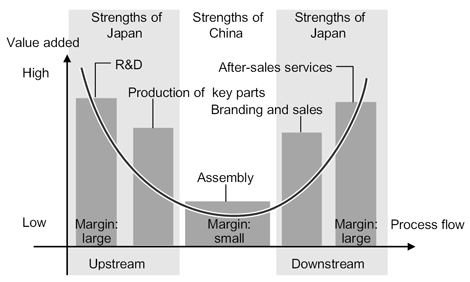
More specifically, Japanese companies can anticipate many business opportunities in the following areas in China (Japan-China Economic Association, "Japan-China Economic and Industrial White Paper 2013/2014 - Accelerating Structural Changes in China and Rebuilding of Japan-China Businesses," 2014).
- (1) Urban construction and infrastructure development: Smart community, eco-city, decentralized energy systems, power generation facilities, urban transportation (subways, urban transportation control systems), iron and steel, sewage and drainage treatment facilities, refuse disposal facilities, waste recovery and reuse, communication network, housing construction, offices and commercial facilities, and construction machinery
- (2) Building facility: Elevators, air conditioning systems, lighting, and BEMS (Building Energy Management System)
- (3) Transportation: Electric vehicles (EV: passenger cars, buses) and batteries and motors for EV
- (4) General consumer goods: Housing interior (furniture, home appliances, etc.) and office equipment (business machines such as PCs and copiers)
- (5) Services and distribution
- (6) Healthcare (prevention, diagnosis, medical treatment, prognosis, etc.)
- (7) Food safety (plant factory, organic vegetables and cultivation, logistic systems, etc.)
- (8) Nursing care, elderly care (facilities: hardware and software, operation and management of senior citizens' home, welfare and nursing care services, etc.)
- (9) Environmental protection (pollution control measures for air, water, and soil), and energy saving
- (10) Recreation (animation, movies, etc.)
- (11) Others (food services, personnel training and temporary personnel services, schools, cram schools, hospitals, management of apartments and condominiums, convenience stores, cultivation and culture, financial services, etc.)
Improving political relations is a precondition for the win-win relationship Unfortunately, these business opportunities are not being fully exploited at present, given the strained political relations between the two countries. Various China threat theories, which are gaining momentum, are casting a damper on business by Japanese companies in China (see Box). Their impact has been particularly noticeable since September 2012, when large-scale anti-Japan demonstrations occurred in many parts of China.
According to the "FY2013 Survey (the 25th) Report on Overseas Business Operations by Japanese Manufacturing Companies," the results of an annual survey on Japanese manufacturers' overseas business operations, published by the Japan Bank for International Cooperation (JBIC) in November 2013, China has receded from the top ranking, which it had maintained since the beginning of the survey, and ranks fourth behind Indonesia, India, and Thailand in terms of its potential as a country/region for business development over the medium term (approximately three years). Its share of the vote (multiple answers allowed) has also fallen sharply, from 62.1% in 2012 to 37.5%.
In fact, as Japan-China relations deteriorate, many Japanese companies have adopted a "China Plus One" strategy, in which they avoid concentrating their investments in China, to diversify risk. Consequently, although still investing in China, these companies also invest in other countries at the same time. Reflecting this strategy, Japanese investment in China declined 17.6% year on year in 2013 (in yen terms, Ministry of Finance, "Balance of Payment Statistics"). In addition, Japan's exports to China, which overtook those to the United States for the first time in 2009, reversed once again, with the United States reemerging as Japan's leading export market in 2013. Although China's share of world imports continues to grow, its share of Japan's exports has fallen from 19.7% at the peak in 2011 to 18.5% in 2013 (Ministry of Finance, "Trade Statistics of Japan"). Meanwhile, China is distancing itself from Japan much more rapidly than the other way around, and the presence of Japan in China is fading in comparison to that of Europe and the United States.
In Japan-China relations, the two forces of increasing closeness on the economic front and conflict on the political front are likely to continue to work concurrently in the future. As Karl Marx argues, the economic base will eventually determine the political superstructure, and by extension, if economic relations deepen, political relations will also improve. In the short term, however, the deterioration of political relations has already had an adverse impact on economic relations between Japan and China. Both countries are seeking to improve the troubled relationship, and if a summit between Japan and China, which has not been held since Prime Minister Yoshihiko Noda visited China in May 2012, becomes reality with the Asia-Pacific Economic Cooperation (APEC) summit in Beijing in November 2014, it will be a large step toward that goal.
Box: Summary of various China threat theories
With the rapid rise of China as a backdrop, various China threat theories have emerged in Japan. Areas of concern extend into not only national security but also the economy, resources, and the environment. China risk theories that emphasize the vulnerability of China are also flourishing. A summary of the issues raised by these theories follows.
Military threat
Japan is deeply concerned about the military expansion of China in recent years. The Defense of Japan 2014 white paper, published in August 2014, showed strong concern about the establishment of the Air Defense Identification Zone (ADIZ) by China across a wide swath of the East China Sea in November 2013, saying that "such measures are profoundly dangerous acts that unilaterally change the status quo in the East China Sea, escalating the situation, and that may cause unintended consequences in the East China Sea." The paper also issued a pointed warning on China's maritime advances in the East China Sea and the South China Sea, noting that China's announced defense budget has grown approximately 40-fold over the past 26 years and that "China has adopted so-called assertive measures, including attempts to alter the status quo by coercive measures based on China's own assertion which is incompatible with the existing international law and order."
Economic threat
Using cheap labor as a weapon, China is taking jobs away from Japan and bringing in their place an industrial hollowing out and deflation by manufacturing and exporting cheap products in large quantities. In addition, China exposes Japan to unfair competition as it avoids costs through a lack of action on infringements on intellectual property rights and environmental destruction, while artificially controlling the exchange rate of yuan and neglecting the welfare of workers. Some have even argued that deflationary pressure originating from China is the main cause of the long-term stagnation of the Japanese economy.
Pressure on resources and the environment
High growth in the Chinese economy has been achieved with the input of large quantities of resources, most of which are dependent on imports from overseas. This has resulted in a surge in resource prices worldwide, and has sped up the depletion of some resources such as oil over the long term. In addition, China has already become the world's largest energy consumer and carbon emitter, overtaking the United States, and the heavy consumption of resources, energy in particular, has led to environmental deterioration not only in China but also internationally. In Japan, the adverse impact of China's environmental problems, such as yellow sand and acid rain, has been long feared. The food safety problem and the serious atmospheric pollution problem caused by PM2.5, which have attracted public attention in recent years, have also prompted Japanese companies to avoid China.
China risks
In contrast to various China threat theories above based on the rise of China, the China risk theory considers the vulnerability of China. First, as a medium- and long-term problem, a rapid decline in China's potential growth rate because of labor supply restrictions has been pointed out. In the short term, China could also experience long-term stagnation following the burst of its real estate bubble, just like Japan did from the 1990s. Moreover, social problems such as discontent among minority groups, the widening income gap, and corruption among bureaucrats are also becoming more serious. In addition to these macro risks, conflicts over historical perceptions and the territorial issues between the two countries are also regarded as major risks facing Japanese companies doing business with China.


